Introduction
Nurserymen, homeowners, landscapers, and pest control operators encounter many diseases on ornamental plants. Rust diseases are among the most common diseases caused by fungi. This publication presents information on four representative rust diseases of ornamentals including gladiolus rust, daylily rust, frangipani rust, and guava rust. These diseases can be severe and cause similar damage on the hosts for which they are named as well as several related species. Many additional rust diseases occur on ornamental plants not mentioned in this publication. Rust diseases are unsightly and affect overall plant health. Some rusts are also diseases of regulatory significance in Florida and the United States.
Gladiolus Rust
Gladiolus rust is a recent introduction to Florida (April 2006) and is of major concern to the gladiolus cut-flower industry. The disease has been confirmed around the world on nearly every continent. Trade has been the primary means of movement for the pathogen, which can be found on all plant parts as a contaminant, although the spores are produced only on above-ground parts. Cut flowers are a major pathway for movement. Gladiolus rust is currently under eradication in the United States from both Florida and California. The disease can cause a complete loss of gladiolus crops in the absence of fungicides and is considered a quarantine pest; early detection and destruction of the pathogen are important in management of gladiolus rust.
Host Range
Primary host: gladiolus hybrids (also called sword lily)
Minor/secondary host: crocosmia
Latin names of hosts: Anomatheca laxa (false freesia), Crocosmia aurea, C. aurea var. aurea, Gladiolus dalenii (sword-lily), Gladiolus x hortulanus, G. psittacinus (dragon's-head-lily), G. saundersii, Gladiolus spp., Melasphaerula ramosa, Tritonia lineata, T. securigera, T. squalida, Tritonia spp., Watsonia spp., W. angusta, W. densiflora, and W. meriana (bulbil Watsonia).
Symptoms and Signs
Initial symptoms of the disease include small yellow spots (lesions) on the leaves, which progress to the formation of small sporulating pustules (uredinia). Unlike many rusts on monocots, rust pustules on gladiolus do not run parallel to the veins. As the full name of the pathogen, Uromyces transversalis, indicates, this rust produces pustules horizontally, or transverse to the direction of the veins. The pustules have a yellow color and, as spores are produced, the affected leaf areas may take on a dusty yellow appearance. As the disease progresses, the sporulating pustules may become yellowish-orange, and the leaf lesions may turn dark brown to black. Lesions may coalesce, leaving large portions of the leaf unable to photosynthesize, destroying the plant's ability to manufacture food and increase the size of the corm. This negatively impacts later flower production.
The fungus is an obligate parasite, indicating that it must have a living green host for survival. Infection of gladiolus plants is most severe when temperatures are between 10°C and 20°C and leaves remain wet for at least 12 hours. The incubation period is shorter when temperatures are in the higher range of this spectrum.
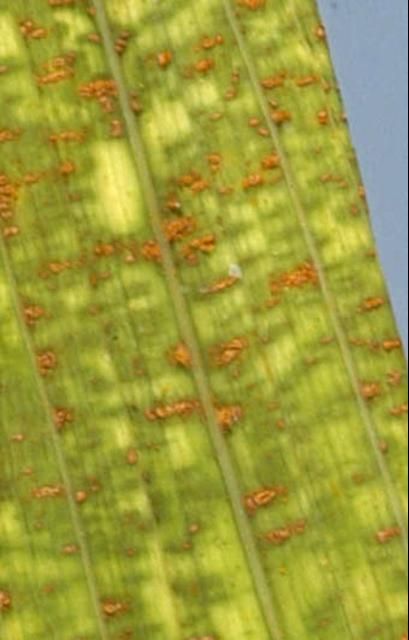
Credit: FDACS-DPI
Management
Homeowners who think they may have found the symptoms mentioned above on gladiolus, crocosmia, or any other host above should contact their local UF/IFAS Extension agent or a Florida Department of Agriculture and Consumer Sciences, Division of Plant Industry (DPI) inspector. UF/IFAS Extension faculty should send samples to a UF/IFAS Plant Disease Diagnostic Clinic for confirmation.
Gladiolus producers are encouraged to leave a host-free period between crops to minimize availability of green tissue for infection. Additionally, production should occur in areas away from home gardens that may include the primary or other hosts (see list above) to reduce exposure to possible reservoirs of disease. Fungicides are available for management. Triazoles are chemicals such as myclobutanil, propiconazole, tebuconazole, or triadimefon. These products provide systemic activity with the ability to get into the plant tissue. Another group of systemic fungicides is the strobilurins which include azoxystrobin, pyraclostrobin and trifloxystrobin. Many contact fungicide products provide cheaper alternatives but are generally applied more often and at higher rates than systemic products (see additional fungicide options in General Chemical Management below).
Cut flowers must be inspected prior to shipment to ensure they are free of visible indications of the disease. Other management and regulatory information is available from the DPI. DPI personnel conduct surveys and inspections; locations of known infections and the regulatory response are published through the Commissioner of Agriculture and the DPI website and other publications. Survey and inspection procedures and regulations can be found in the USDA-APHIS "National Management Plan for Exclusion and Eradication."
Daylily Rust
Daylily rust is caused by the fungus, Puccinia hemerocallidis. The disease is native to Asia and was confirmed in the US in 2000. First detected in Florida and Georgia, it has now been confirmed in over 30 states and eradication efforts have been terminated. Spores are produced prolifically and quickly by the fungus and are spread by wind and human movement of plants. An alternate host, Patrinia, has been identified, of which six species are sold in the US, but this host is not required for the spread of the disease.
Host Range
Primary host: Hemerocallis spp. (daylily) (see Management, below, for cultivar information)
Alternate host: Patrinia spp. (Family Valerianaceae) (Golden valerian)
Symptoms and Signs
Symptoms of daylily rust include yellow to brown vertical streaks on the foliage and small yellow spots on the upper surface of the leaf. As the disease progresses, leaves become chlorotic and will eventually senesce. Signs of the fungus include pustules containing dusty orange urediniospores on the undersides of daylily leaves, usually constrained by plant veins into long, vertical streaks. Signs of the fungus in the fall include dark, thick-walled, fungal structures (telia) on the underside of daylily leaves. These survival structures germinate in the spring, producing teliospores that can infect the alternate host.
Symptoms may be confused with aphid feeding or daylily leaf streak, caused by the fungus Aureobasidium macrostictum, but no orange pustules will develop from either of these organisms.
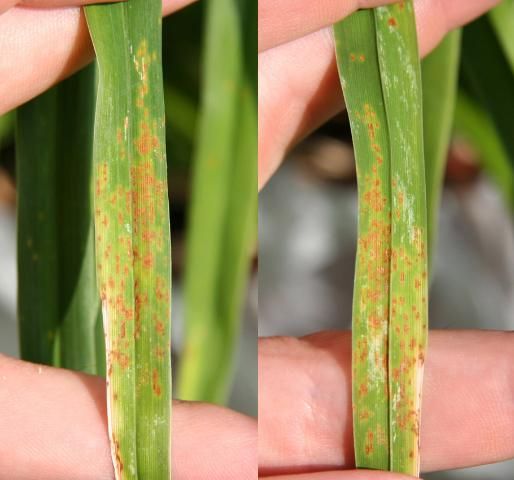
Credit: Philip F. Harmon, UF/IFAS
Management
Management of daylily rust depends largely on utilization of resistant cultivars and good sanitation practices. Fungicides may be considered by commercial producers to ensure healthy and pathogen-free plants for production and shipment.
Cultivar selection should be aimed at those cultivars that have been tested and found to be resistant. In addition, daylilies and the alternate host, golden valerian, should not be grown in the same area. The lists below are limited to those that have been tested for susceptibility to the pathogen and are not complete. Information on cultivar susceptibility may be found in the Cornell University Daylily Rust Fact Sheet http://plantclinic.cornell.edu/factsheets/daylilyrust.pdf.
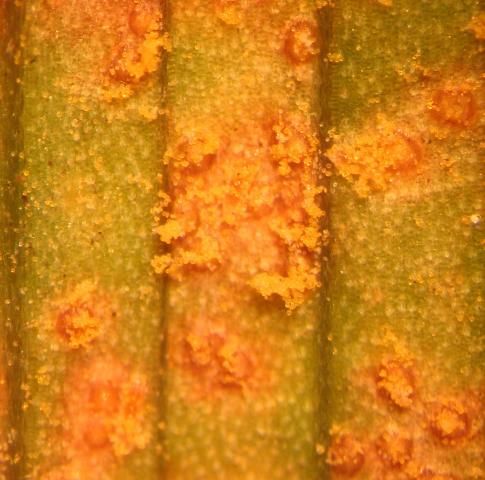
Credit: Carrie L. Harmon, UF/IFAS
Very susceptible:
Attribution, Colonel Scarborough, Crepe Eyed Ruffles, Double Buttercup, Flower Shop, Hello Sunshine, Imperial Guard, Irish Ice, Karie Ann, Lemon Yellow, Little Gypsy Vagabond, Lonesome Dove, Ming Toy, Pandora's Box, Pardon Me, Patience Plus, Pink Beacon, Quannah, and Rosie Pinkerton, Royal Ebony, Russian Rhapsody, Silken Touch, Siloam Doolebug, Siloam Ralph Henry, Solomon's Robes, Splendid Touch, Springtime Treasurer, Violet Explosion, White Wow, and Woodland Romance.
Moderately susceptible:
Butterflake, Crystal Tide, Gertrude Condon, Joan Senior, Prelude to Love, Star Struck, Stella D'Oro, and Wilson's Yellow.
Very resistant:
Age of Gold, All-American Hero, Antique Rose, Barbara Mitchell, Butterscotch Ruffles, Catherine Neal, Creole Blush, Dainty Designer, Devonshire Cream, Ed Brown, Fashion Design, Femme Fatale, Gentle Rose, Golden Monday, Happy Returns, Heartfelt, Holy Spirit, Joie de Vivre, Joleyne Nichole, Lavender Bonnet, Lilac Lady, Mac the Knife, Mae West, Meadow Sweet, Neon Pink, Pink Flirt, Prairie Blue Eyes, Raspberry Splash, Siloam Bill Monroe, Siloam Double Classic, Siloam Ury Winnifors, and Yangtze.
Sanitation practices are important for homeowners and producers. Remove all plant residue in the fall, disposing of it away from the growing site, burning it, or burying it. Trim newly purchased plants to remove all foliage in the spring before planting. This will reduce the chance of introduction of the disease into landscape or production areas.
Fungicides may be useful for high-value or commercially produced plants. Use fungicides labeled for Puccinia on ornamentals in FL. If an infection is detected, a fungicide program including weekly or periodic treatment may be necessary due to the rate of reproduction of the pathogen and growth of the host. (See additional fungicide options in General Chemical Management below).
Frangipani Rust
Frangipani rust (also called plumeria rust) was first detected on Plumeria sp. in Guatemala in 1907. The disease is caused by the fungus Coleosporium plumeriae and has been confirmed in the Caribbean, South and Central America, Africa, Taiwan, Hawaii and the continental US, and many of the Pacific islands. The disease is spread by windborne spores and human movement of plants.
Host Range
Plumeria spp. (frangipani) P. acuminata, P. acutifolia, P. alba, P. clusioides, P. rubra, P. obtusa, and P. variegata.
No alternate or alternative hosts have been confirmed.
Symptoms and Signs
Symptoms of the disease appear as small angular chlorotic spots on the upper leaf surface, which coalesce into chlorotic and necrotic lesions. Leaves become chlorotic and eventually senesce and drop, with defoliation sometimes approaching 100% on some species. Signs of the pathogen include abundant pustules of yellow-orange urediniospores on the lower leaf surface during the growing season and darker yellow-orange telia in the fall. Telia are often mixed with uredinia.
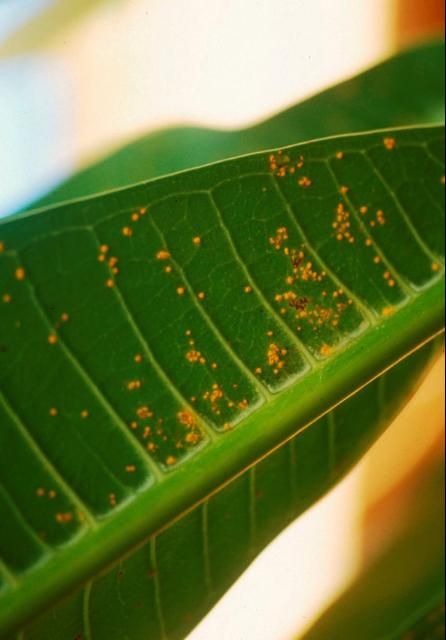
Credit: Stephen Brown, UF/IFAS
Management
Plumeria rubra is a common species in Florida landscapes, and is severely affected by the disease, often becoming defoliated when environmental conditions are ideal for disease development. Plumeria obtusa has been reported to show some tolerance to the disease in Hawaii.
Minor infections may be managed in the home landscape by removing infected leaves and destroying them. Fungicides labeled for ornamental rusts in Florida may be beneficial in nursery and production areas, although timing and application are critical, and periodic application will be necessary to manage the disease throughout the production of the plants (see additional fungicide options in General Chemical Management below).
Guava Rust
Guava is grown in Florida for both its ornamental value and fruit production. Guava rust (also called eucalyptus rust and ohia rust) affects guava as well as the ornamentals listed below and is caused by the fungus Puccinia psidii. The rust has been confirmed in South and Central America, the Caribbean and the US, including Florida and Hawaii. The disease is a major threat to guava production and is a serious potential threat to Eucalyptus spp. Interestingly, the rust is under investigation as a possible biocontrol for the invasive weed melaleuca (Impact of Puccinia Psidii on the Performance of Invasive Tree Melaleuca Quinquienervia in Florida https://www.ars.usda.gov/research/publications/publication/?seqNo115=188332).
Host Range
Psidium guajava (guava), Eucalyptus spp., Pimento officinalis (allspice), and Syzgium aromaticum (clove), Melaleuca quinquenervia (melaleuca), Callistemon sp., Corymbia sp., Eugenia sp., Marlierea sp., Myrica spp.
No alternate hosts have been identified.
Symptoms and Signs
Symptoms of the disease on guava include chlorotic flecks which coalesce into brown lesions, shoot tip dieback, fruit lesions and rot, deformed leaves, heavy defoliation and, under severe infestation, stunted growth and even plant death. Signs of the pathogen include abundant pustules of bright yellow urediniospores on buds, fruit and undersides of the leaves. Pustules can coalesce, covering entire portions of the plant in spores. Dark reddish-tan telia are produced during hot weather on mature plant tissue and appear with uredinia. Urediniospores can remain viable for months during transport, providing a mechanism for spread on packing materials.
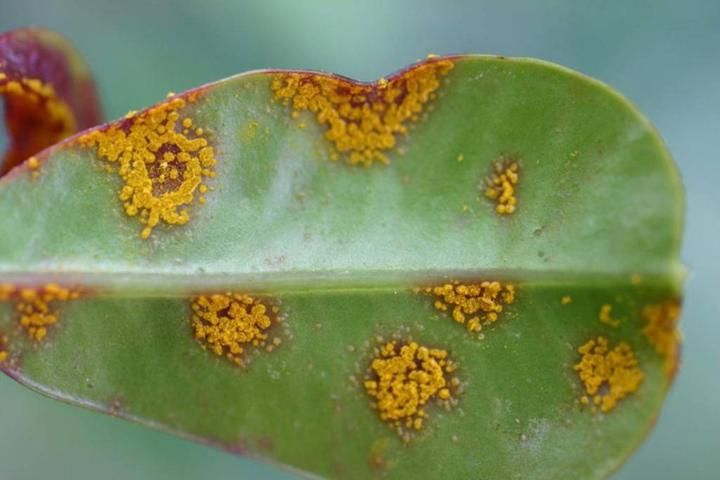
Credit: Stephen Brown, UF/IFAS
Management
Homeowners can remove infected fruit and leaves and can apply fungicides labeled for guava and rust in Florida. Fungicides should be used in production areas to protect the flowers, fruit, and plant health. Care should be taken to disinfest machinery and tools to lessen the chance of spread.
General Chemical Management
Fungicides are valuable tools for production and maintenance of ornamental plants.
Both contact and systemic type fungicides are available for management of rust diseases. Contact products generally provide from 3 up to 14 days protection and only protect those plant parts that are directly sprayed. Systemic fungicides move into the plant and can provide up to 21 days of protection from rust. Managing rust on the most susceptible cultivars often requires repeat applications of multiple products. A list of fungicide products labeled for rust diseases of commercial ornamental plants is available in the EDIS publication Professional Disease Management Guide for Ornamental Plants https://edis.ifas.ufl.edu/publication/PP123. Homeowners should refer to the Homeowner's Guide to Fungicides for Lawn and Landscape Maintenance https://edis.ifas.ufl.edu/publication/PP154.
Care must be taken to ensure the product has the site and specific plant or broad clearance with "notice to user" on the label before purchasing and applying. Rotate different groups of fungicides to prevent the development of fungicide resistance.
References
USDA-APHIS National Management Plan for Exclusion and Eradication https://www.aphis.usda.gov/aphis/ourfocus/planthealth/plant-pest-and-disease-programs/pests-and-diseases/plant-disease/sa_gladiolus_rust/ct_gladiolus_rust
USDA-ARS publication 115 https://www.ars.usda.gov/research/publications/publication/?seqNo115=188332
Cornell University Daylily Rust Fact Sheet http://plantclinic.cornell.edu/factsheets/daylilyrust.pdf [6 September 2011]